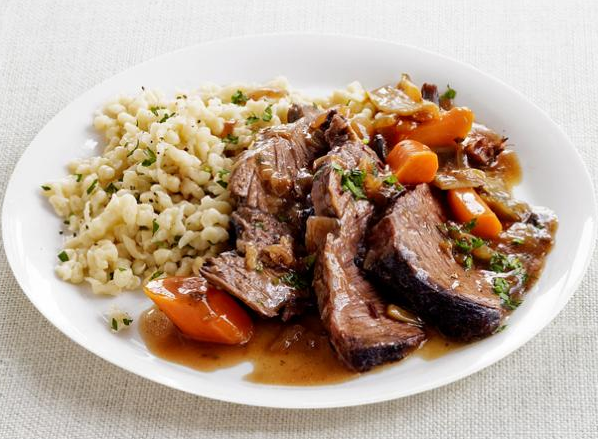Welcome to the delicious world of Chilean cuisine! In this article, we will dive into the exquisite flavors of Chile National Dish, Cazuela de Ave. As a human and country expert, I will guide you through the rich history, traditional recipe, regional variations, culinary significance, and more. So, let’s embark on this culinary journey and explore the wonders of Cazuela de Ave!
What is Cazuela de Ave?
Cazuela de Ave, also known as chicken cazuela, is a hearty and comforting Chilean soup. It is considered the country’s national dish and holds a special place in Chilean households and restaurants alike. The word “cazuela” refers to the clay pot traditionally used to cook the dish, while “ave” means chicken in Spanish.
History and Origin of Chile National Dish
Cazuela de Ave has a fascinating history that dates back to the colonial era when Spanish influence merged with indigenous ingredients and cooking techniques. This culinary masterpiece combines elements of Spanish stews with local South American flavors, resulting in a unique dish that reflects Chile’s cultural heritage.
Ingredients used in Chile National Dish
To prepare an authentic Cazuela de Ave, you will need the following ingredients:
- Chicken (preferably bone-in for enhanced flavor)
- Onions
- Garlic
- Potatoes
- Pumpkin
- Corn on the cob
- Rice or pasta
- Peas
- Carrots
- Green beans
- Cilantro
- Salt and pepper
Traditional Recipe
- In a large pot, sauté onions and garlic until golden brown.
- Add chicken pieces and brown them on all sides.
- Pour enough water to cover the chicken and bring it to a boil.
- Skim off any impurities that rise to the surface.
- Add potatoes, pumpkin, corn on the cob, rice or pasta, peas, carrots, and green beans.
- Season with salt and pepper to taste.
- Reduce the heat and simmer for about an hour until the flavors meld together.
- Sprinkle fresh cilantro on top before serving.
Regional Variations
While the core ingredients remain consistent across Chile, there are regional variations of Cazuela de Ave that showcase the diversity of the country. In the coastal areas, seafood such as fish, mussels, or clams may be added to the soup. In the Andean regions, indigenous herbs and spices are incorporated, adding a distinct flavor profile.
Nutritional Benefits
Cazuela de Ave is not only a delicious dish but also a nutritious one. Packed with lean protein from chicken, essential vitamins from vegetables, and energy-rich carbohydrates from rice or pasta, this dish provides a balanced and wholesome meal. The inclusion of corn and pumpkin adds a dose of fiber and antioxidants, promoting overall health and well-being.
Culinary Significance of Chile National Dish
Cazuela de Ave holds a special place in Chilean culinary traditions. It is often served during family gatherings, celebrations, and special occasions. The slow simmering process allows the flavors to develop and intensify, creating a deeply satisfying and aromatic dish that brings people together.
Popular Accompaniments
Cazuela de Ave is typically enjoyed with a side of freshly baked bread, which is perfect for dipping into the flavorful broth. It pairs well with a refreshing glass of Chilean wine or a traditional drink like “mote con huesillos” – a sweet peach and husked wheat beverage.
Cooking Tips
- For enhanced flavor, use bone-in chicken pieces instead of boneless.
- Skimming off impurities while the soup simmers ensures a clear and clean broth.
- Adjust the cooking time based on your preference for tender or firmer vegetables.
Chile National Dish: Serving Suggestions
When serving Cazuela de Ave, present it in individual bowls filled with the aromatic broth, a piece of chicken, and an assortment of vegetables. Encourage your guests to add their desired condiments, such as freshly squeezed lemon juice or a dollop of spicy pebre sauce, to elevate the flavors even further.
Cultural Significance of Chile National Dish
Cazuela de Ave represents the heart and soul of Chilean cuisine. It symbolizes warmth, family bonds, and the richness of the country’s culinary heritage. Sharing this dish with loved ones is not only a gastronomic experience but also a celebration of Chilean culture and traditions.
Health Considerations
While Cazuela de Ave is a wholesome and nutritious dish, individuals with specific dietary restrictions or allergies should exercise caution. It’s important to adapt the recipe according to individual needs and consult a healthcare professional if necessary.
Conclusion
Cazuela de Ave, the national dish of Chile, showcases the flavors, history, and cultural significance of the country. This hearty chicken soup brings together diverse ingredients in a harmonious blend that satisfies the palate and warms the heart. So, embrace the Chilean culinary heritage and indulge in the deliciousness of Cazuela de Ave.
FAQs
- Is Cazuela de Ave spicy?
No, Cazuela de Ave is not typically spicy. However, you can add spices or condiments according to your preference.
- Can I use boneless chicken for Cazuela de Ave?
While bone-in chicken is traditionally used, you can adapt the recipe and use boneless chicken if desired.
- Are there vegetarian versions of Cazuela de Ave?
Yes, vegetarian versions of Cazuela de Ave exist, where chicken is replaced with plant-based alternatives like tofu or seitan.
- Can I freeze Cazuela de Ave for later consumption?
Yes, Cazuela de Ave can be frozen for later consumption. Ensure proper storage in airtight containers to maintain its flavors.
- What are other popular Chilean dishes?
Chile boasts a variety of delicious dishes such as empanadas, pastel de choclo, and completo (a Chilean-style hot dog).
References:
- “Cazuela: La Reina de la Mesa Chilena.” Chile es Tuyo, Gobierno de Chile, www.chileestuyo.cl/en/destinos-y-rutas/gastronomia/cazuela-la-reina-de-la-mesa-chilena.
- “Cazuela de Ave: El Plato Más Popular de Chile.” ComoHacerPara.com, www.comohacerpara.com/cazuela-ave-plato-popular-chile-26820c.html.
- “Cazuela de Ave.” SaborGourmet.com, www.saborgourmet.com/recetas/cazuela-de-ave.
- “Cazuela.” Food and Agriculture Organization of the United Nations, www.fao.org/in-action/globefish/fishery-information/resource-detail/en/c/1072275.

